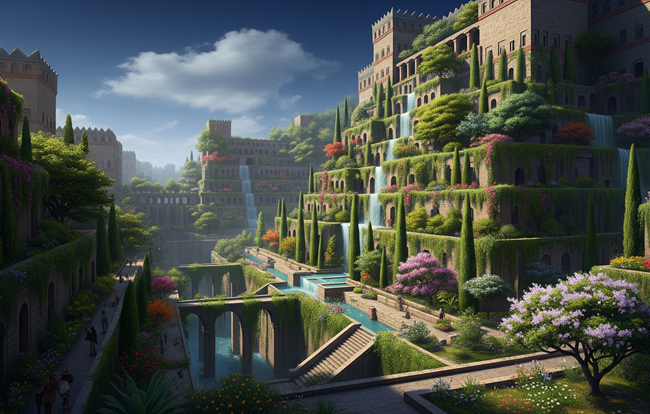Remember taking a class on Ancient Civilization? Do you remember how civilization was made possible? One of the main reasons is that man learned how to irrigate and cultivate plants. Until the development of agriculture, everyone lived a nomadic lifestyle and would move to wherever food was available. Somewhere along the line people must have figured out that plants needed water to grow and probably started watering a plant. From there, a garden would be the next step and getting water to ensure the plants grow would be the next. Thus, the birth of irrigation!

What are Sub-Irrigated Planters
The simplest form of irrigation was discovered in the areas near rivers. In these locations, water naturally seeps up through the soil so plant roots can pull up the moisture and grow. If you start digging a hole several feet away from a river you’ll eventually reach water. Back fill that same hole with soil and you have a continuous source of water. This is known as sub-irrigation. There is little evaporation and always enough moisture for the plants.
People developed this idea and created sub-irrigated planters, also known as SIPs. A SIP is a vessel that has a reservoir in the bottom, a sieve above the water, soil above the sieve, and a refill tube going from the top of the planter down to the reservoir, for refilling water. Using a wicking action, the plant roots suck water from the reservoir, through the soil up and into the plant. SIPs hail from the birthplace of civilization: The Hanging Gardens of Babylon.
The Hanging Gardens of Babylon is one of the Seven Wonders of the Ancient World. The gardens used subsurface irrigation to grow a man-made forest in the desert. The hanging gardens were built on monolithic stones with large walking areas around the gardens for people to enjoy. Water was fed through the bottom to irrigate the gardens at all times. There were large basins using an aqueduct design to transfer water along the bottom of the gardens.
Although the gardens were destroyed by earthquakes somewhere after the 2nd century BC., there are many historical accounts of the gardens. The most noted account is that by Philo of Byzantium (writing ca. 250 BC), in his list of the Seven Wonders of the Ancient World. Philo wrote in great detail explaining how the gardens were designed, with many notes on the water systems that were used for decoration and irrigation. These descriptions help us understand ancient irrigation techniques.
How Sub-Irrigated Planters Work
SIPs are a highly efficient way to grow plants because very little water is lost to evaporation. When you add water to the fill tube, the water goes directly below the soil and into a reservoir. The plant roots wick the water from the reservoir through natural capillary action. SIPs can be used individually or in series to create large flowing gardens as was done in Babylon.
Although SIPs today are most commonly used as decorative planters, they have many other uses including container gardening. SIPs like the EarthBox can be assembled in minutes and placed on nearly any semi-flat surface (patios, decks, on top of walls, roofs, indoors, parking lots, etc.). They can turn virtually any location into a vegetable or flower garden without the need of working the soil for months at a time. Since they do not require much space, any urban home owner can use one or two units and grow food or flowers or both. This means that as long as there is light and a place to put the container, there is a potential spot for a SIP.
With a SIP you can create your own “Hanging Gardens”. There are several situations where SIP gardens are extremely useful. Let’s look at some scenarios on why you need at least one Sub-Irrigated Planter.
- Any vacant lot that has contaminated soil on the property is a potential site because the plant roots never touch the ground. There is no worry of getting sick from whatever the plants took up through their roots. In fact, you would be able to grow organic vegetables even on top of a brownfield!
- Flood waters carry a slew of contaminants with them: sewage, paints, fuels, animal wastes, etc. Since SIPs allow one to plant a garden immediately (the same day), it is possible to have fresh foods much sooner in an area that could take months or years to recover.
- An area that has been polluted with a host of pesticides and herbicides, or other chemicals that are contaminating the soils are great places for SIPs. If someone purposely overfills the reservoir in the SIP, the overflow is loaded with microorganisms that remediate the soils on which they spill. In a matter of months, they have started to bio-remediate the surrounding area as well, leaving it in better shape than when they first started using it.
- When The Zombie Apocalypse happens, and there are no more deliveries of food, a SIP kit that is all ready to go, wheels and all, is a perfect portable garden that can be set up in a matter of minutes.
Sub-Irrigated gardening has been going on for thousands of years and is highly efficient. SIPs are portable; are great to use anywhere there is light and temperatures above freezing; are drought tolerant; and can clean contaminated areas. With sub-irrigated planters we don’t have to worry about what’s in the soil below our planters, even if it is contaminated or it is just a slab of concrete. It kind of lets you tap into your ancient ancestors method of survival.
Eric Lancaster is Executive Vice President of TeraGanix, Inc., the exclusive North America distributor of Effective Microorganisms® and EM® Bokashi products. He is the technical expert on Effective Microorganisms® for the US market.




Comment here